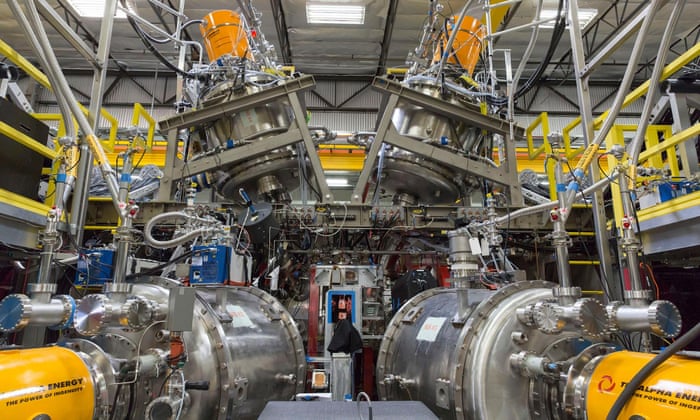
Central confinement chamber of C-2U, a plasma confinement experiment comprising 10,000 engineering control tags and 1,000 physics diagnostics channels at Tri Alpha Energy’s research facility in California, US. The algorithm will cut the time it takes to work out best possible options to form plasma from a month to just a few hours. Photograph: Courtesy of Tri Alpha Energy Inc.
Google and a leading nuclear fusion company have developed a new computer algorithm which has significantly speeded up experiments on plasmas, the ultra-hot balls of gas at the heart of the energy technology.
Tri Alpha Energy, which is backed by Microsoft co-founder Paul Allen, has raised over $500m (£383m) in investment. It has worked with Google Research to create what they call the Optometrist algorithm. This enables high-powered computation to be combined with human judgement to find new and better solutions to complex problems.
Nuclear fusion, in which atoms are combined at extreme temperatures to release huge amounts of energy, is exceptionally complex. The physics of nuclear fusion involves non-linear phenomena, where small changes can produce large outcomes, making the engineering needed to suspend the plasma very challenging.
“The whole thing is beyond what we know how to do even with Google-scale computer resources,” said Ted Baltz, at the Google Accelerated Science Team. So the scientists combined computer learning approaches with human input by presenting researchers with choices. The researchers choose the option they instinctively feel is more promising, akin to choosing the clearer text during an eye test.
“We boiled the problem down to ‘let’s find plasma behaviours that an expert human plasma physicist thinks are interesting, and let’s not break the machine when we’re doing it’,” said Baltz. “This was a classic case of humans and computers doing a better job together than either could have separately.”
Working with Google enabled experiment’s on Tri Alpha Energy’s C2-U machine to progress much faster, with operations that took a month speeded up to just a few hours. The algorithm revealed unexpected ways of operating the plasma, with the research published on Tuesday in the journal Scientific Reports. The team achieved a 50% reduction in energy losses from the system and a resulting increase in total plasma energy, which must reach a critical threshold for fusion to occur.
“Results like this might take years to solve without the power of advanced computation,” said Michl Binderbauer, president and chief technology officer at Tri Alpha Energy. He said the company was aiming to produce electricity within a decade and Tri Alpha Energy recently added former US energy secretary Ernest Moniz to its board of directors.
The C-2U machine ran an experiment every eight minutes. This involved blasting plasma with a beam of hydrogen atoms to keep it spinning in a magnetic field for up to 10 milliseconds. The aims was to see if it behaved as theory predicts and is a promising route to a fusion reactor that generates more energy than it consumes.
The Optometrist algorithm enabled the researchers to discover a configuration in which the hydrogen beam completely balanced the cooling losses, meaning the total energy in the plasma actually went up after formation. “It was only for about two milliseconds, but still, it was a first!” said Baltz.
The C2-U machine has now been replaced with a more powerful and sophisticated machine called Norman, after the company’s late co-founder Norman Rostoker. It achieved first plasma earlier in July and if experiments on Norman are successful, Tri Alpha Energy will next build a demonstration power generator.
Nuclear fusion has long held the hope of clean, safe and limitless energy and interest has increased as the challenge of climate change and the need to cut carbon emissions has become clear. But despite 60 years and billions of dollars of research, it has yet to be achieved and commercial scale nuclear fusion is still likely to be decades away.
But numerous other groups are chasing the nuclear fusion dream, with the largest by far the publicly funded Iter project in southern France. The €18bn (£16bn) project is a partnership of the US, the European Union, China, India, South Korea, Russia and Japan, and is building a seven-storey facility.
Iter uses a conventional tokamak, or doughnut-shaped, reactor and aims to create its first plasma in 2025, scaling up to its maximum power output by 2035. If successful, Iter could be the foundation of the first fusion power plants.
Other groups are experimenting with different fusion reactor designs that might be better and, in particular, smaller. A €1bn reactor opened in Germany in 2016 uses a stellarator in which the plasma ring is shaped like a Mobius strip, giving it the potential to operate continuously, rather than in pulses as in a tokamak.
There are also a series of private companies, staffed by experienced fusion researchers, including General Fusion, which uses a vortex of molten lead and lithium to contain the plasma and is backed by Amazon’s Jeff Bezos.
Lockheed Martin’s famous Skunk Works team said in 2014 they would produce a truck-sized fusion plant within a decade but attracted criticism for providing few details. The UK’s Tokamak Energy is aiming to harness particle accelerator technology and high-temperature superconductors and other firms include Helion Energy and First Light Fusion
David Kingham, chief of Tokamak Energy said the Tri Alpha Energy was exciting progress: “While publicly funded laboratories excel at fundamental research, the private sector can innovate and adopt new technologies much more rapidly.” In April, Tokamak Energy achieved first plasma in a new reactor, its third in five years, and aims to reach the 100m degrees centigrade needed for fusion in 2018.
[“Source-theguardian”]




